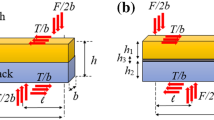Abstract
Asymmetric four point bend specimens are often used for determination mode II fracture toughness. Different corrections were proposed to classical solution of Stress Intensity Factors for this specimen. This paper provides a solution for a bi-material four point specimen with sub-interface crack. The solutions were obtained using Finite Element Analysis, and the effect of crack distance to interface, crack length and materials combination were investigated.
Similar content being viewed by others
References
Aliha, M.R.M., Ayatollahi, M.R., Kharazi, B. (2008) Numerical and Experimental Investigations of Mixed Mode Fracture in Granite Unsing Four-Point-Bend Specimen in Fracture and Damage Mechanics, Eds. T. Boukharouba, M. Elboujdaini, G. Pluvinage, Springer, 2009.
He M.Y., Hutchinson J.W. (2000) Asymmetric Four-Point Crack Specimen. Journal of Applied Mechanics 67: 207–209
Huang Z., Suo Z., Xu G., He J., Prevost J.H., Sukumar N (2005) Initiation and arrest of an interfacial crack in a four-point bend test. Engineering Fracture Mechanics 72: 2584–2601
Hutchinson J.W., Mear M.E., Rice J.R. (1987) Crack paralleling an interface between dissimilar materials. Journal of Applied Mechanics 54: 828–832
Marsavina L., Sadowski T. (2009) Fracture parameters at bi-material ceramic interfaces under bi-axial state of stress. Computational Materials Science 45(3): 693–697
Murakami Y. (1987) Stress Intensity Factors Handbook. Pergamon Press, New York
Reinhardt H.W., Ozbolt J., Xu S., Dinku A. (1997) Shear of structural concrete members and pure mode II testing. Advanced Cement Based Materials 5: 75–85
Shahani A.R., Tabatabaei S.A. (2008) Computational of mixed mode stress intensity factors in a four-point bend specimen. Applied Mathematical Modelling 32: 1281–1288
Tada H., Paris P., Irwin G.R. (1985) The Stress Analysis of Cracks Handbook. Del Research Corp., St. Louis
Tilbrook M.T., Moon R.J., Hoffman M. (2005) Finite element simulations of crack propagation in functionally graded materials under flexural loading. Engineering Fracture Mechanics 72: 2444–2467
Tilbrook M.T., Rozenburg K., Steffler E.D., Rutgers L., Hoffman M. (2006) Crack propagation paths in layered, graded composites. Composites: Part B 37: 490–498
Author information
Authors and Affiliations
Corresponding author
Rights and permissions
About this article
Cite this article
Marsavina, L., Piski, T. Bimaterial Four Point Bend Specimen with Sub-Interface Crack. Int J Fract 164, 325–332 (2010). https://doi.org/10.1007/s10704-010-9490-9
Published:
Issue Date:
DOI: https://doi.org/10.1007/s10704-010-9490-9




